 |
 |
 |
| |
BASELINE CHARACTERISTICS AND WEEK 4 RESPONSE AMONG CHRONIC HEPATITIS C PATIENTS INFECTED WITH HCV GENOTYPE 1, 2, 3 OR 4: INTERIM RESULTS OF THE PROPHESYS TRIAL
|
| |
| |
EASL April 23-26 2009 Copenhagen
Reported by Jules Levin
G. Dusheiko,1 F.A. Caruntu,2 M. Bourliere,3 D. Ouzan,4 S. Pol,5 C. Ferrari,6 M. Puoti,7 A. Tice,8 G.F. Silva,9 G. Lengyel,10 C. Ghent,11 D. Messinger,12 A. Tietz,13 A. Mangia14
1Centre for Hepatology, Royal Free and University College School of Medicine, London, UK; 2National Institute of Infectious Diseases, Bucharest, Romania; 3Hopital Saint-Joseph, Marseille, France; 4Institut Arnault-Tzanck, Saint-Laurent-du-Var, France; 5Hopital Necker, Paris, France;
6Azienda Ospedaliera - Ospedali Riuniti, Parma, Italy; 7University of Brescia, Brescia, Italy; 8University of Hawaii, Honolulu, USA; 9Botucatu School of Medicine, Botucatu, Brazil; 102nd Department of Medicine, Semmelweis University, Budapest, Hungary; 11London Health Sciences Centre, London, Canada;
12Biometrics, IST GmbH, Mannheim, Germany; 13Roche, Basel, Switzerland; 14Ospedale Casa Sollievo della Sofferenza, San Giovanni Rotondo, Italy
This study was sponsored by Roche, Basel, Switzerland
AUTHOR CONCLUSIONS
In this large cohort of patients, marked differences were observed in patient demographics when grouped by genotype. In particular, genotype 3-infected patients tended to be younger, were more likely to be male and were less likely to be obese or to have advanced fibrosis than patients infected with HCV genotype 1 or 2.
An RVR was achieved in a high proportion of patients, especially among those infected with HCV genotype 2 or 3 (81.7% and 73.0%, respectively).
The proportion of genotype 1 patients with an RVR at week 4 (21%) was similar to the rate observed in a large randomised pivotal study (20%),[5, 7] despite the use of a much more sensitive qualitative assay in the present study (limit of detection 15 IU/mL versus 50 IU/mL, respectively).
There are a substantial number of patients without an RVR who experience a decrease in HCV RNA of ≥2 log10. The predictive value of these responses for SVR will be evaluated as more results become available.
Baseline factors strongly associated with an RVR in genotype 1-infected patients (HCV RNA level, race, age, histological diagnosis and ALT ratio) were similar to those observed in large randomised clinical trials.
Introduction
The combination of pegylated interferon plus ribavirin is the standard of care for the treatment of chronic hepatitis C.[1, 2] Randomised controlled trials have shown that this combination can eradicate hepatitis C virus (HCV) in more than 50% of patients.[3-5] Analyses of data from such trials provide insight into the variety of patient- and treatment-related factors that modify the probability of achieving a cure.[6-8]
Randomised controlled trials typically enrol a homogenous group of patients whereas observational studies of patients managed in routine clinical care enrol a more heterogeneous population and so can provide valuable additional information regarding demographics of patients currently under treatment and factors predictive of responses. Such studies can be used to test treatment strategies that are established in controlled clinical trials. For example, it has recently been shown that, in addition to individuals who achieve a rapid virological response (RVR, undetectable HCV RNA at week 4) genotype-1 infected patients with substantial reductions in HCV RNA from baseline (i.e., detectable but unquantifiable or greater than or equal to a 2- or 3-log drop) have a high probability of achieving an sustained virological response (SVR).[9]
The ongoing prospective observational study on Predictors of early on-treatment response on sustained virological response in a cohort of treatment-naive HCV patients treated with pegylated interferons (PROPHESYS) trial is a large, multinational study of patients treated for chronic hepatitis C. The population under study includes treatment-naïve patients and those pre-treated with conventional interferon monotherapy. Patients could be treated with either peginterferon alfa-2a (40KD) (PEGASYS) or pegylated interferon alfa-2b (12KD). The present analysis is restricted to naive patients treated with peginterferon alfa-2a (40KD) plus ribavirin (COPEGUS).
OBJECTIVE
We present the results of an interim analysis among treatment-naïve patients treated with peginterferon alfa-2a (40KD) and ribavirin.
METHODS
Patients
Patients aged 18 years or older were eligible for enrolment in PROPHESYS provided that they had chronic HCV infection, had not received antiviral therapy for HCV infection and were not co-infected with hepatitis B virus or human immunodeficiency virus.
Patients with cirrhosis were eligible provided that they had compensated disease.
Pregnant women are excluded from participation in PROPHESYS. Moreover, all fertile male and female patients, and female partners of male patients are required to use two forms of effective contraception during treatment and for 6 months after completing treatment.
Patients included in this interim analysis were required to have a documented baseline and week 4 HCV RNA assay result after initiation of treatment.
Treatment
Eligible patients were treated with subcutaneous peginterferon alfa-2a (40KD) plus oral ribavirin according to current prescribing recommendations. The intended duration of treatment and dose of ribavirin were determined by HCV genotype, RVR status at week 4 and the standard of care at each participating clinic.
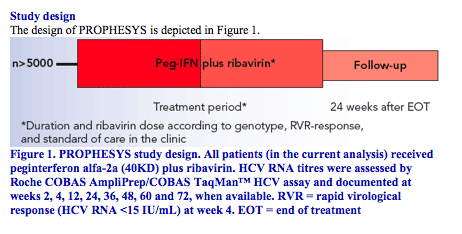
Outcomes
The primary objective of PROPHESYS is to determine the predictive value of a virological response (undetectable HCV RNA) at weeks 4 and 12 of treatment for SVR.
RVR was defined as negative HCV RNA (<15 IU/mL) by a highly sensitive quantitative polymerase chain reaction assay (COBAS AmpliPrep/ COBAS TaqMan HCV Test) at week 4.
RESULTS
As of 25 August 2008 a total of 2627 patients had been enrolled, of whom 1550 had initiated treatment with peginterferon alfa-2a (40KD) plus ribavirin and had both a baseline and a week 4 HCV RNA assay result. The patient population included in this analysis is depicted in Figure 2.
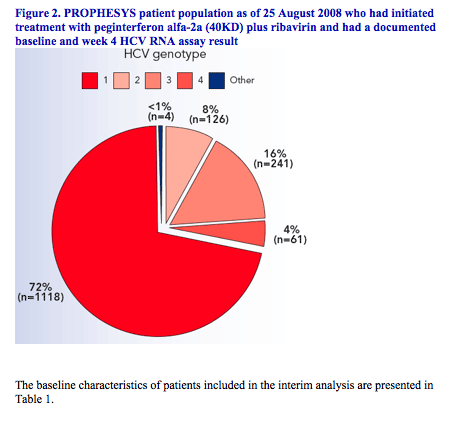
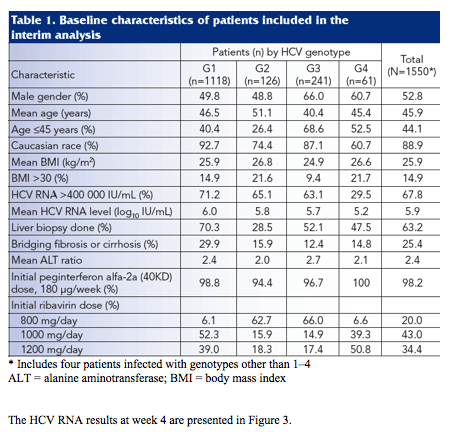
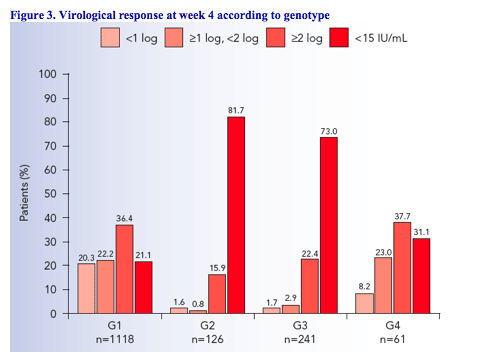
Multiple logistic regression analysis of potential baseline factors associated with an RVR at week 4 in genotype 1 patients showed that lower baseline HCV RNA level, higher alanine aminotransferase (ALT) ratio, Caucasian race, younger age and an absence of advanced fibrosis were positive predictors of RVR (Figure 4).
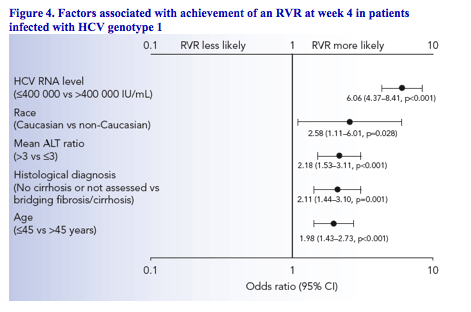
REFERENCES
1. Dienstag JL, McHutchison JG. American Gastroenterological Association medical position statement on the management of hepatitis C. Gastroenterology 2006; 130(1):225-230.
2. Strader DB, Wright T, Thomas DL, Seeff LB. Diagnosis, management, and treatment of hepatitis C. Hepatology 2004; 39(4):1147-1171.
3. Manns MP, McHutchison JG, Gordon SC et al. Peginterferon alfa-2b plus ribavirin compared with interferon alfa-2b plus ribavirin for initial treatment of chronic hepatitis C: a randomised trial. Lancet 2001; 358(9286): 958-965.
4. Fried MW, Shiffman ML, Reddy KR et al. Peginterferon alfa-2a plus ribavirin for chronic hepatitis C virus infection. N Engl J Med 2002; 347(13):975-982.
5. Hadziyannis SJ, Sette H, Jr., Morgan TR et al. Peginterferon-alpha 2a and ribavirin combination therapy in chronic hepatitis C: a randomized study of treatment duration and ribavirin dose. Ann Intern Med 2004; 140(5):346-355.
6. Ferenci P, Fried MW, Shiffman ML et al. Predicting sustained virological responses in chronic hepatitis C patients treated with peginterferon alfa-2a (40KD)/ribavirin. J Hepatol 2005; 43(3):425-433.
7. Jensen DM, Morgan TR, Marcellin P et al. Early identification of HCV genotype 1 patients responding to 24 weeks peginterferon alpha-2a (40KD)/ribavirin therapy. Hepatology 2006; 43(5):954-960.
8. Foster GR, Fried MW, Hadziyannis SJ et al. Prediction of sustained virological response in chronic hepatitis C patients treated with peginterferon alfa-2a (40KD) and ribavirin. Scand J Gastroenterol 2007; 42(2):247-255.
9. Marcellin P, Reau N, Ferenci P, Jensen DM. Refined prediction of week 12 response and SVR based on the virological response at week 4 in HCV genotype 1 patients treated with peginterferon alfa-2a (40KD) (PEGASYS) and ribavirin (COPEGUS). Hepatology 2008; 48(4 Suppl):1136A.
|
| |
|
 |
 |
|
|